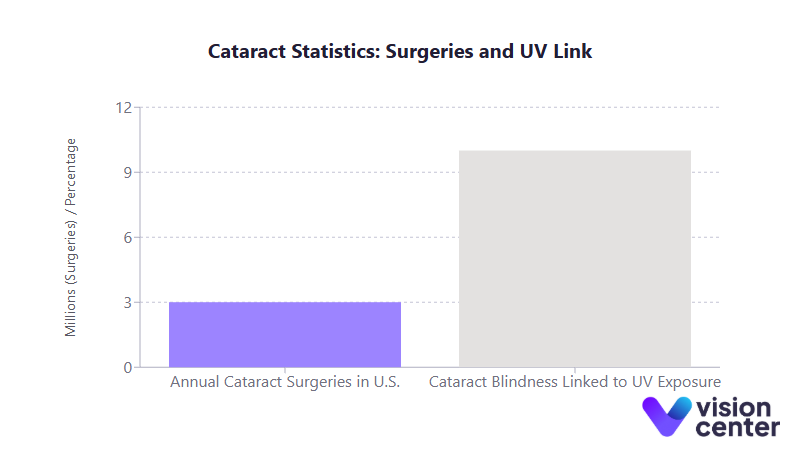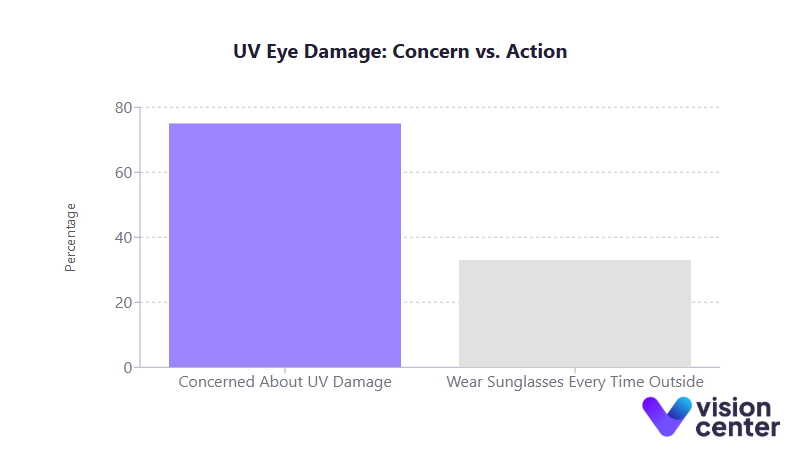Updated on March 21, 2025
How Does UV Exposure Affect Eye Health?


Vision Center is funded by our readers. We may earn commissions if you purchase something via one of our links.
Ultraviolet (UV) radiation can cause serious harm to our eyes, yet it’s often overshadowed by concerns about skin protection. Many individuals understand that UV rays pose a risk, but fewer consistently safeguard their vision with proper eyewear or habits.
This article takes a data-driven look at UV eye protection. After a brief overview of the broader topic, you’ll find key statistics that highlight current trends and demographics. Then, in-depth sections examine how UV exposure varies, why it matters for eye health, and what prevention programs are achieving.
Broader Overview
UV radiation is invisible energy emitted by the sun. It’s divided into three bands: UV-A, UV-B, and UV-C. While UV-C is largely absorbed by the ozone layer, UV-A and UV-B reach Earth’s surface and can penetrate biological tissues, including the eye’s delicate structures. Overexposure can result in both acute effects like photokeratitis (sunburn of the cornea) and long-term conditions such as cataracts, pterygium, and possibly certain eye cancers.
Scientists, health agencies, and eye care organizations have studied these impacts for decades. Their research demonstrates consistent patterns: individuals in high-UV regions and those who do not wear protective eyewear face elevated risk.
Yet surveys reveal that, although awareness of UV dangers is growing, there is still a gap between what people know about sun safety and what they practice, especially regarding eye protection.
Key Statistics at a Glance
- Children have high exposure: In some sunny regions, less than 15% of children wear sunglasses regularly, even though their clearer lenses let in far more UV rays than an adult’s.
- Adult usage varies: Up to 70% of U.S. adults wear sunglasses sometimes, but only about 31% report wearing them every time they go outside.
- Healthcare costs: Each year, around 3 million cataract surgeries are performed in the United States, costing billions of dollars; roughly 10% of cataract blindness worldwide may be linked to UV overexposure.
- Protective potential: Research shows properly rated sunglasses that block 99 to 100% of UV rays can reduce ocular UV exposure by as much as 99%, significantly lowering the risk of many eye conditions.

UV Exposure Patterns
UV exposure to the eye depends heavily on factors like geography, environment, and individual behavior. Understanding these patterns is essential for targeted prevention and resource allocation.
Regional and Seasonal Variations
- High-altitude and southern regions in the United States (e.g., Arizona, Florida) receive the most intense UV radiation. In summer, UV Index values can reach extreme levels, whereas far north regions record lower averages.
- Seasonal changes are also dramatic: UV is highest in summer months (especially June and July) and lowest in winter. However, up to 80% of UV can penetrate through light cloud cover, making it a year-round concern even in colder seasons.
- Reflective surfaces such as snow, sand, or water can double effective UV exposure. Fresh snow reflects more than 80% of UV rays, leading to a higher risk of “snow blindness” in winter sports if no protective eyewear is used.
Demographic Differences in Exposure
- Outdoor workers and those in sunny climates accrue higher total UV doses due to extended time outside.
- Children and teenagers typically spend more hours outdoors and often do so without sunglasses. Studies suggest that a child’s eye transmits far more UV-A to the retina compared to an adult’s. Some experts estimate up to half a person’s total lifetime UV dose hits the eyes by age 18.
- Medication factors: Certain drugs (e.g., tetracyclines, some diuretics) can increase the eye’s sensitivity to UV. Older adults who take these medications may face enhanced susceptibility despite their normally less-transparent lenses.
The Effectiveness of Protective Measures
It’s widely recognized that the consistent use of sunglasses rated to block UV-A and UV-B is among the most straightforward ways to protect one’s vision. Below are the key protective measures and how well they work.
Sunglasses, Hats, and More
- UV-blocking sunglasses: Quality lenses labeled “100% UV” or “UV400” block both UV-A and UV-B. The darkness of lens tint does not necessarily equate to UV protection. What matters is the UV-blocking coating. Wraparound styles or large lenses help shield peripheral rays.
- Wide-brimmed hats can reduce the amount of direct UV reaching the eyes by up to 50%, particularly around midday.
- UV-blocking contact lenses shield only the portion of the eye covered by the lens and do not protect the eyelids or surrounding skin, so they should be paired with sunglasses for complete coverage.
- Shade-seeking and clothing options: Staying in the shade during peak hours (10 a.m. to 4 p.m.) is a helpful strategy, though reflected UV from surfaces still poses a risk to unprotected eyes.
Below is a concise comparison of protective methods and their approximate impact on UV exposure:
| Protective Measure | Approx. UV Exposure Reduction | Key Notes |
| 99–100% UV-blocking sunglasses | Up to ~99% | Look for UV400 or “100% UV” label; larger lenses or wraparound styles help. |
| Wide-brimmed hat | Up to ~50% | More effective at midday sun angles; a hat alone is insufficient to block reflected rays. |
| UV-blocking contacts | 90 to 99% of UV through lens only | Protect internal eye structures but not eyelids, so sunglasses are still recommended. |
| Seeking shade | Greatly lowers direct UV | Indirect UV from reflective surfaces can remain significant. |
Public Awareness Gaps
- Surveys indicate 75% of Americans are concerned about UV eye damage, yet only around one-third wear sunglasses every time they head outside.
- More recent data shows a rise in sunglass usage: in one national survey, 70% of respondents said they wear sunglasses at least some of the time. Nevertheless, only about half confirm that the lenses they purchase have proper UV-blocking labels.
- Parents underutilize protective strategies for kids: fewer than one-third report requiring their children to wear UV-rated eyewear, despite children’s heightened vulnerability.

Health Impacts of UV on Eyes
While many people associate UV damage with sunburned skin, the eyes are also at risk. Both short-term and long-term ocular conditions are influenced by UV exposure.
Common UV-Related Eye Conditions
- Photokeratitis (“sunburn” of the cornea): This acute injury can cause intense pain, tearing, and temporary vision loss. It often happens after exposure to bright reflections (like snow) without protective eyewear.
- Cataract: The leading cause of blindness worldwide. Research suggests that 10% or more of cataract blindness may be attributable to UV rays. Since cataracts typically develop in older age, the accumulated effect of decades of inadequate sun protection is a known factor.
- Pterygium (“surfer’s eye”): Benign growth of tissue that can encroach onto the cornea, often in individuals who work or spend long periods outdoors. It may cause visual distortion and can require surgery if it blocks the pupil.
- Eye and eyelid cancers: Prolonged UV exposure is associated with higher risk of certain eyelid skin cancers and possibly uveal melanoma inside the eye. Although less common than skin cancers, these can be serious if they occur.
- Age-related macular degeneration (AMD): While age and genetics are the primary drivers, UV light is considered a possible contributing factor to oxidative stress in the retina. Protecting eyes from UV, starting early in life, may help reduce AMD risk.
Age-Based Susceptibility
- Children have clearer ocular lenses, so a higher percentage of UV passes through to deeper eye structures. Surveys repeatedly show youth have among the lowest rates of sunglass use.
- Adults in midlife are often unaware that visible changes in the lens (which become yellower with age) can filter out more UV, yet damage incurred earlier still accumulates.
- Older adults face higher rates of cataracts and AMD. Even though their lenses block more UV, ongoing exposure can still exacerbate these conditions, and certain medications in older populations can heighten UV sensitivity.
Economic and Social Consequences
Beyond the direct effects on vision, UV-related eye disorders impose sizable costs on individuals, families, and healthcare systems.
- Cataract surgery is one of the most common surgeries in the United States, with roughly 3 million procedures annually. The average cost per procedure can range from $2,000 to $3,000 or more, indicating billions of dollars in national spending.
- Pterygium removal also adds cost, though less frequently than cataract procedures.
- Workforce productivity takes a hit when photokeratitis or other conditions lead to temporary or permanent vision impairment. Delayed treatment, whether for cataracts or more complex issues like ocular cancers, can escalate healthcare expenses and reduce quality of life.
- Preventive efforts offer a major return on investment: educational programs that promote sun safety have been estimated to save multiples of their cost by preventing future eye (and skin) conditions.
Intervention Outcomes and Trends
Prevention Programs
- School-based education: The Environmental Protection Agency’s SunWise program showed that children who received sun safety lessons reported fewer sunburns and more frequently wore sunglasses. Incorporating UV eye health into such curricula has demonstrated tangible behavioral shifts.
- Awareness campaigns: Annual events like UV Safety Month and National Sunglasses Day, championed by organizations such as the American Academy of Ophthalmology and The Vision Council, have helped increase public knowledge. Recent surveys indicate more Americans than ever are wearing sunglasses, citing UV protection as a motivating factor.
- Global initiatives: The World Health Organization’s INTERSUN project promotes the UV Index as a tool for public awareness worldwide. Programs in Australia, under the SunSmart banner, are often cited as success stories for integrating eye protection alongside skin safety, with measurable reductions in sun-related harm.
Tracking Long-Term Effects
- Behavioral metrics: Comparing new survey data to older baselines reveals that more people consistently wear sunglasses and rate UV protection as a top purchasing criterion.
- Disease incidence: A decline in cataract prevalence attributable specifically to UV reduction is difficult to measure in the short term. However, regions that have long-standing sun protection campaigns (e.g., Australia) have reported lower rates of certain sun-related eye conditions than areas with comparable climates but fewer protective practices.
- Healthcare expenditure: If fewer surgeries or treatments are needed due to better prevention, overall health costs could decline over time. Health agency models suggest that even a modest delay in cataract onset could produce notable savings.
Final Summary
UV radiation is an unavoidable part of daily life, especially for people in sunny climates or at high altitudes. Research over the last half-decade consolidates a clear message: while awareness of UV’s harm to eyes is on the rise, consistent protection is still lacking, particularly among children and teenagers who accumulate the highest long-term exposure.
Fortunately, prevention is straightforward. Well-rated sunglasses, wide-brimmed hats, and mindful outdoor practices significantly reduce the risks of cataracts, pterygium, and other UV-related conditions.
Ongoing public health initiatives, both in schools and broader campaigns, are proving successful in nudging behavior. If these efforts continue, experts predict fewer cases of preventable eye diseases, potentially saving billions in healthcare costs and preserving vision for countless individuals.
In essence, safeguarding the eyes from UV not only protects sight today but also reduces the likelihood of vision impairment decades down the road. As more people adopt protective habits, society stands to reap both health and economic benefits. The challenge ahead lies in reinforcing these strategies, especially for children, so that eye safety becomes a natural, lifelong commitment.
In this article
11 sources cited
Updated on March 21, 2025
Updated on March 21, 2025
About Our Contributors
Mara Sugue, with a B.A. in Social Sciences, is a dedicated web content writer for Vision Center. She is committed to making eye health research accessible and understandable to people from diverse backgrounds and educational levels. Her writing aims to bridge the gap between complex vision health topics and readers' needs for clear, factual information.
Dr. Melody Huang is an optometrist and freelance health writer with a passion for educating people about eye health. With her unique blend of clinical expertise and writing skills, Dr. Huang seeks to guide individuals towards healthier and happier lives. Her interests extend to Eastern medicine and integrative healthcare approaches. Outside of work, she enjoys exploring new skincare products, experimenting with food recipes, and spending time with her adopted cats.

